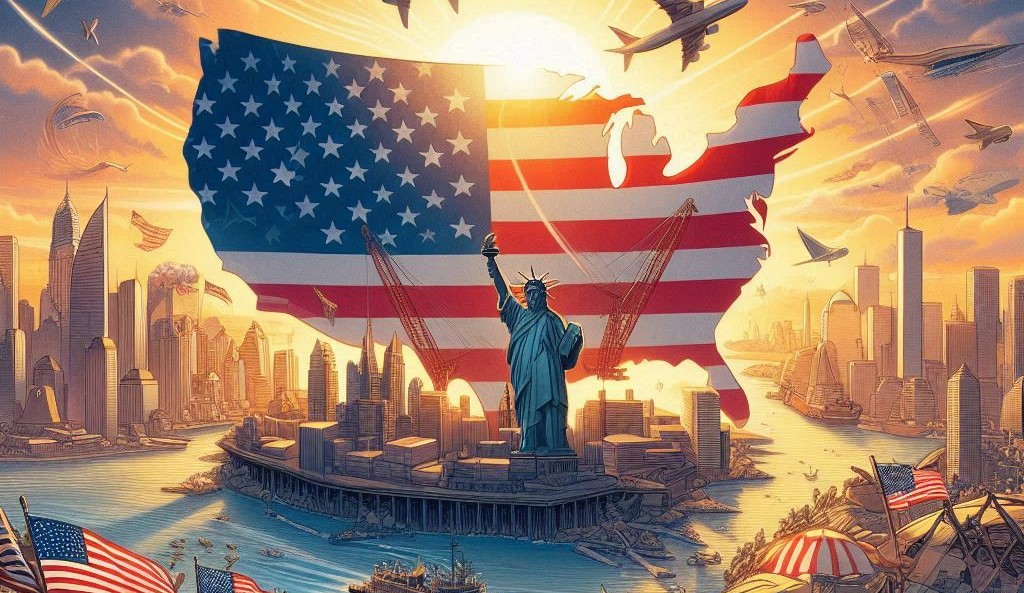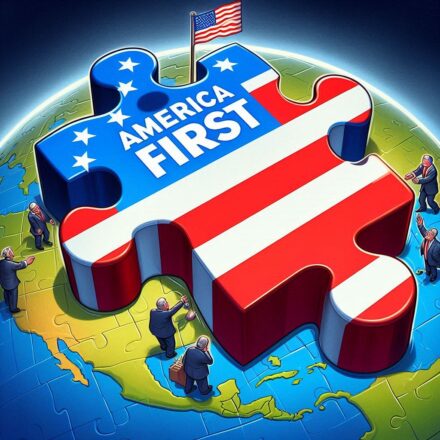- Empty cart.
- Continue Shopping
The Trump Triumph: How America’s 2024 ‘America First’ Shift Could Reshape the World

With Donald Trump’s victory in the 2024 U.S. presidential election, global dynamics are poised for significant change. This election outcome signals a return to “America First” policies, which could reshape trade, technology, military alliances, and climate policy. Below is a closer look at how Trump’s leadership could impact the world—and some intriguing facts about what lies ahead.
Trade Revolution: The “Tariff Tsunami”
- Trump has proposed a baseline 10-20% tariff on most imports to boost American manufacturing and reduce dependency on foreign goods. This “tariff tsunami” could redefine the global trade network and pressure countries reliant on U.S. trade, like China and Mexico, to rethink their exports. Analysts estimate that these policies could impact over $500 billion in global trade, forcing companies to restructure supply chains to avoid high tariffs. Countries may respond by negotiating regional trade deals that bypass the U.S., which could create a fragmented economic landscape and impact the cost and availability of certain goods in the American market.
Climate Rollbacks and Energy Independence
- Trump’s previous administration saw the U.S. exit the Paris Climate Accord, a stance he could revive with his return. This potential rollback on climate commitments may signal an increased focus on fossil fuels, with Trump likely emphasizing energy independence. If this trend continues, experts believe that the U.S. could become the world’s largest oil producer by 2025, a shift that would likely affect global oil prices and put pressure on other energy-exporting nations. The absence of U.S. leadership in international climate efforts might slow down global climate progress, as other countries may struggle to meet emissions targets without the collaborative structure previously supported by the U.S.
The NATO and Alliance Challenge
- Trump’s approach to NATO could once again become more transactional, with an emphasis on “burden-sharing” among member countries. He has previously criticized NATO allies for not contributing enough to collective defense and may push for increased defense budgets from European countries. This could strain U.S.-Europe relations and lead allies to seek alternative security arrangements. For example, European countries may consider forming more independent defense coalitions within the EU. In Asia, countries like Japan and South Korea may also feel pressure to bolster their own defense systems and invest in regional security alliances to counterbalance the reduced U.S. presence.

- Trump’s restrictive stance on Chinese tech companies like Huawei and TikTok could escalate into a broader “digital iron curtain” between the U.S. and China. Experts predict that these measures could lead to two distinct tech ecosystems, as companies in the U.S. and China adjust to limited interoperability and regulatory restrictions. This could intensify competition in technology fields like artificial intelligence, telecommunications, and cybersecurity. Additionally, global companies may face challenges in choosing which ecosystem to align with, potentially impacting innovation and pushing countries to develop tech infrastructure that can navigate both American and Chinese markets.
The Economic Shake-Up: A ‘Buy American’ Boost
- Trump’s revived “Buy American, Hire American” initiative is expected to funnel billions of dollars back into U.S. manufacturing, particularly in sectors like steel, automotive, and technology. This initiative is designed to strengthen American industry and promote job growth domestically. However, markets reliant on U.S. imports, such as those in Latin America and Southeast Asia, could face economic downturns if these policies significantly reduce trade. Furthermore, this shift may drive up the costs of certain goods for American consumers, as domestic products tend to be more expensive than their imported counterparts.
Global Impact Summary
- Trump’s policies are expected to introduce volatility in global markets, increase regional defense autonomy, and widen the economic gap between the U.S. and its trading partners. His “America First” approach could lead to a more polarized international landscape, encouraging countries to build regional partnerships and economic agreements that reduce reliance on the U.S. This transformative period in global relations may also push the EU, China, and other economic powerhouses to compete for influence in areas traditionally dominated by the U.S.
In summary, Trump’s 2024 victory not only redefines U.S. policy but also sets the stage for major global shifts. As countries adapt to these changes, we may see an increase in regional coalitions and trade alliances designed to counterbalance the impacts of America’s evolving global stance. This new “Trump-era” could encourage a complex, multipolar world where the influence of the United States is both strategically prioritized and actively countered.
